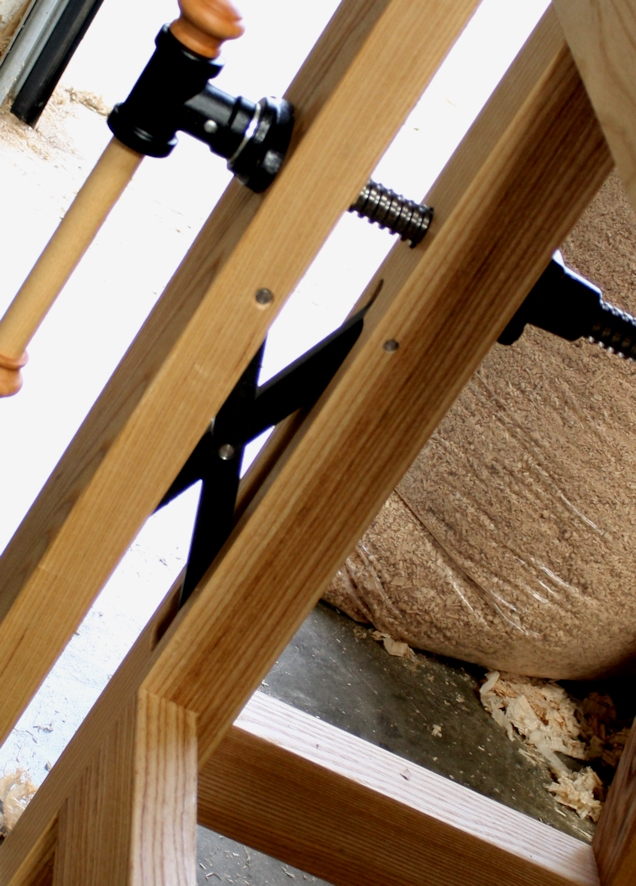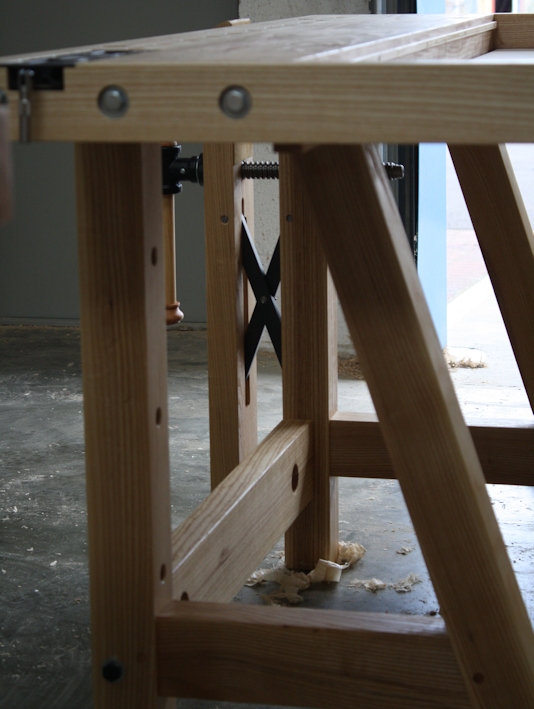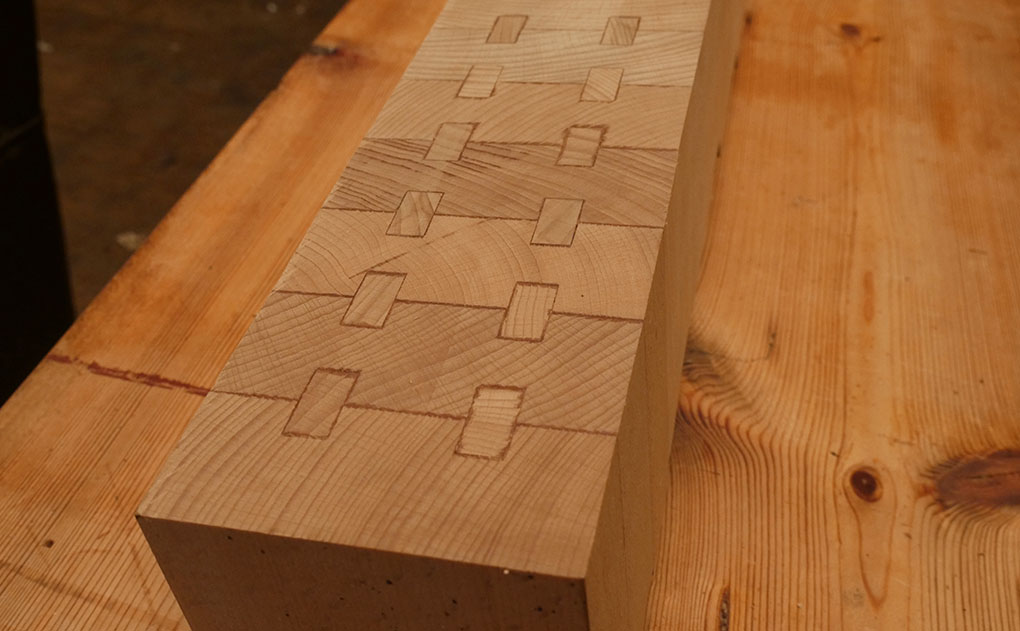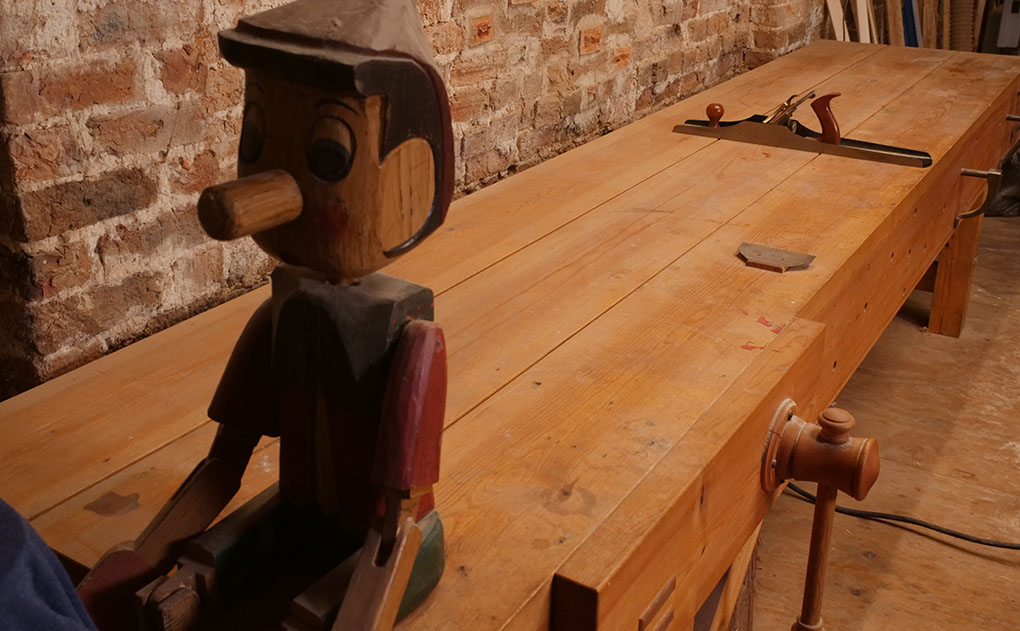
This is to be our first vice to go in to the new (yet to be named) range of sensibly priced, well made hardware. It’s a pinless leg vice with St Peter’s cross mechanism.
The steel screw has a nice rapid thread which is custom made to be coarser than normal to give a faster pace of opening, making it that bit closer to being like using a wooden screw. The cross is very simple and very reliable but it’s taken quite some thought to create just the right size. We now have it so it can fit in to even a very low workbench without interfering with the base joinery.
One restriction when using wooden screws and other expensive vices is they ideally require a very stout bench to go in to, with large legs, big joinery and a thick vice jaw. This vice is just as at home in a more moderate workbench and can go in to a vice jaw down to 45mm.
We’re now including these as standard in all our Little John workbenches and are currently working on the pricing and arrangements for them to be sold as kits.
Update: At the present time we’re not making any workbenches for sale, however we have many resources on this website that will help guide you with your own workbench build.
Our English Workbench Video Series takes you step by step through a traditional bench build, starting out with a discussion on choosing the ideal dimensions, demonstrations of how to cut the joinery, right through to flattening your workbench top and building the face vice from scratch.
If you’d like us to guide you through your build with detailed videos and PDF plans, then you can find full details for this Workbench Series here.


![Simple Work Holding For Ploughing Grooves [Without a Tail Vice]](https://www.theenglishwoodworker.com/wp-content/uploads/2022/07/workholding-without-tail-vice-copy.jpg)
![Gluing Up A Workbench Leg [VIDEO]](https://www.theenglishwoodworker.com/wp-content/uploads/2022/06/gluing-up-a-workbench-leg-video.jpg)


I like it Richard, nice job guys. Now how many pennies Im I going to have to save. 😉
Thanks Ken, just finalising the pricing and trying to make sure it’s as low as possible. Cheers
Nice work! Good to see all the innovation in bench hardware of late or rebirth perhaps. Also nice to see this is the new standard for little John. I’m sure your customers will appreciate it’s easier to use. Is it easier to fit than a parallel guide as well?
Thanks Jeremy, it’s definitely easier and quicker to fit although perhaps a little less hand tool friendly. It’s just a case of removing material as there’s two fairly large mortices required.
Maguire Workbenches keeps on going from strength to strength,
Well done guys with the hard work
Regards
David
Thanks David, much appreciated 🙂
Sensibly priced, I am all for that. But no true Scotsman would say St Peter’s cross to a St Andrew’s cross. I am curious, why is it named this way?
Hi Damien, that’s a question I’ve heard before and I think there’s a few theories including mistranslation. We’re working on a name for ours, should be something uncreative but at least won’t confuse the Saints. All the best.
Both St Peter and St Andrew were traditionally said to have been martyred on inverted crosses so no confusion and you can take your pick.
Looks brill. I hope it is affordable and that it can be shipped stateside without costing the same again.
Thanks Patrick, it’s pretty compact but then again it’s metal so a fair weight… We’ll have to see.
I would think you could name this one “Pinless Leg Vise, Type II, with Steel Screw” and then if necessary, go back and add to your other one “Pinless Leg Vise, Type I, with Wooden Screw”.
and maybe add “Rapid Thread”
So that’s the “Pinless Leg Vice, Type II, Rapid thread, Steel Screw Mega Vice!” That ought to do it!
Just thought I would put a little ‘thank you’ here as I am mightily impressed with my Little John which was delivered last week.
First job has been to get out some of my seasoned boxwood and turn some little posts for the Veritas inset vice as most of the boards I work with are less than the 13mm height of the supplied dog. Two posts protruding 6-8mm seems to work just fine, though I will probably set them into a little block in due course as it will be less fiddly to lift them out.
Now down the line I am thinking of a second ‘movable’ leg vice to hold longer boards… not sure how this will work yet but was thinking it could perhaps be fixed from the top by a peg going down through one of the dog holes on the bench top and likewise at the bottom rail by bolting through some similarly spaced dog holes… does this sound feasible?
Hi Peter and many thanks for taking the time to comment – I’m really pleased you like your Little John. You may have seen our post last year about the Veritas inset and how we feel it needs a lower dog so I’m pleased you’ve been able to create a solution. It doesn’t sound like you’ll be needing it but we will be sending you an additional low dog from Veritas when they have them ready.
For long boards in a workbench of this size I tend to find the holes in the front leg are in a good place for the additional support, either using a bench dog or holdfast. After working at your bench for a while if you’re still finding that something in between would be useful then let me know and I’ll try to make some suggestions.
Peter,
I too wanted to make a shorter dog for the inset vise. I have an old set of dowel centers. I dug ’round in the little bin until I found a couple of the centers the same size as the holes in the vise. I cut a piece of hardwood 3″ x 1-1/8″ x 7/16″ and laid it down on top of the dowel centers making sure it was fairly square with the vise and then just pushed it down on the spikes of the dowel centers. Then I took the wooden dog piece over to the drill press and drilled a couple (tight) holes. I used short sections of steel rod for the pins. They fit the holes in the inset vise real snug. I pressed them into the wood with my metal vise and there ya’ have it, a shorter dog. I think it is 10mm at the tallest but the pins are about 7mm above the top of the vise. I just felt better knowing I could play around with thinner stock and not hit the dog as easy.
Reading about your idea for a movable vise, I was going to suggest maybe just making a free-standing board jack (bench slave). They are pretty easy to make and can be stored out of the way if you don’t need it.
how to make a cross de St pierre expansion mechanism without spending Hundreds for the Benchcraft version. I can get the hand wheel and threaded bar for a fraction but not the criss-cross mechanism